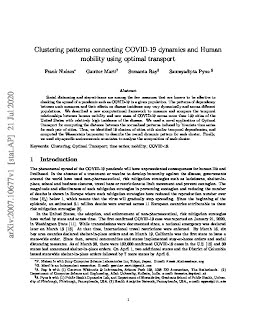2020-07-21
Clustering patterns connecting COVID-19 dynamics and Human mobility using optimal transport
Publication
Publication
Social distancing and stay-at-home are among the few measures that are known to be effective in checking the spread of a pandemic such as COVID-19 in a given population. The patterns of dependency between such measures and their effects on disease incidence may vary dynamically and across different populations. We described a new computational framework to measure and compare the temporal relationships between human mobility and new cases of COVID-19 across more than 150 cities of the United States with relatively high incidence of the disease. We used a novel application of Optimal Transport for computing the distance between the normalized patterns induced by bivariate time series for each pair of cities. Thus, we identified 10 clusters of cities with similar temporal dependencies, and computed the Wasserstein barycenter to describe the overall dynamic pattern for each cluster. Finally, we used city-specific socioeconomic covariates to analyze the composition of each cluster.
| Additional Metadata | |
|---|---|
| , , , , | |
| Organisation | Evolutionary Intelligence |
|
Nielsen, F., Marti, G., Ray, S., & Pyne, S. (2020). Clustering patterns connecting COVID-19 dynamics and Human mobility using optimal transport. |
|

